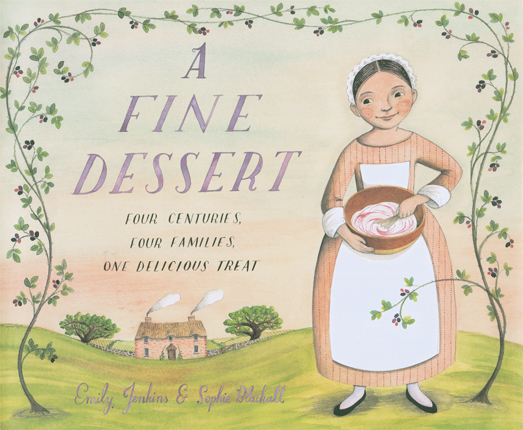Full Text Reviews: School Library Journal - 12/01/2014 Gr 1–3—More than mere confection, A Fine Dessert is a rich and satisfying journey across four centuries, told through the eyes of four families. Beginning with a young girl and her mother picking wild blackberries in Lyme, England in 1710 and ending with a father and son in modern day San Diego, each story is explored through the lens of making Blackberry Fool, a treat consisting of berries, cream, and sugar. Jenkins keeps the text tightly focused on the task at hand: gathering the ingredients, mixing them, presenting the finished dessert, and enjoying the sweet rewards. Each story follows the same pattern, allowing children to observe similarities and differences in across time periods. Technological progress is highlighted in the evolution of the mixing process: from a bundle of clean, soft twigs in the 18th century to a metal whisk made by a blacksmith in the 19th century to a cast-iron rotary beater in the 20th century and finally to the nearly effortless electric mixer in the 21st century. Blackall's ink and watercolor illustrations, accented with real blackberry juice, provide the details that both unify and differentiate the various historical periods. The story set on a Charleston plantation could have been uncomfortable in less capable hands. A spread shows a white family sitting down to supper as a slave family waits upon them. Jenkins and Blackall show rather than tell, allowing young readers to draw their own conclusions about the fact that the characters must hide in a closet to enjoy the dessert they've worked so hard to make. The final spread depicts a modern multigenerational, multicultural gathering. A recipe for Blackberry Fool is included. Simply delectable. —Kiera Parrott, School Library Journal - Copyright 2014 Publishers Weekly, Library Journal and/or School Library Journal used with permission. Booklist - 12/15/2014 *Starred Review* A blackberry fool is a simple recipe that has been around for ages—mashed blackberries are folded into whipped cream, then chilled. In this delightful and informative offering, Jenkins and Blackall show families in four centuries making the sweet treat. The book begins in 1710; a mother and daughter pick berries and whip cream using a whisk made of twigs. About 100 years later, a mother and daughter, slaves on a plantation, pick berries and whip cream, but they use a wire whisk, and they’re only allowed to eat whatever’s left over after serving the masters. Another 100 years later, a mother and daughter buy berries and use a whirring beater, and today, a father and son use an electric mixer to whip cream. The tools and families begin to look different over time, but the recipe is essentially the same, and so is the reaction when kids get a taste—“Mmmmm.” Blackall’s elaborate, antique-like watercolor illustrations are stuffed with historical tidbits, and she includes visual echoes that further link each time period. An author’s note explains some of the history, which will be useful for little ones curious about the differences. And for kids wondering what all the fuss is about over blackberry fool, Jenkins provides a recipe. A delicious book about a delicious treat. - Copyright 2014 Booklist. Bulletin for the Center... - 04/01/2015 This gracefully crafted picture book looks at the tasty old-fashioned dessert of blackberry fool over four centuries. First it’s in England in 1710 that a girl and her mother pick the berries, whip the cream (and lick the spoon!), chill it in a cold spot and then serve it up to the very pleased family. Then it’s in Charleston in 1810 that an African-American woman and her daughter prepare the dessert and then serve it up to the master’s family. In Boston in 1910 a mother and daughter enjoy the convenience of pasteurized cream and a rotary beater as they prepare the dish. Finally, a father and son in 2010 pull the recipe off the internet, shop for the ingredients, enjoy the benefits of electricity in preparing them, and then serve the dessert up to a feast for a multicultural cast of friends. This is classic Jenkins in its seemingly casual, observation-rich text; the folkloric structure of the process (and isn’t the learning of food preparation a kind of folklore?) makes the prose rhythmic and readable, while the changing settings mark the significant historical and industrial shifts over the centuries. The untold backstory of the sequence featuring the enslaved African-American woman challenges the book’s tranquil domestic presentation, but there are subtle indicators (the girl and her mother “hid in the closet” to lick the bowl together) that point the observant to the troubling truth (and the author’s note delves deeper into the issue), and her inclusion is an appropriate acknowledgment of the importance of such women in the culinary tradition. Blackall’s delicate ink and watercolor art is well suited to period portrayals; soft detailing and repeated compositional patterning that echoes the textual repetition makes for attractive design, but there’s enough shadow and precision to give some steel to the sweetness. Sharp-eyed viewers will spot repeated motifs (look for the horse statuette, for instance) and will also note similarities and contrasts even beyond those foregrounded by the text. A recipe for blackberry fool is included; a historical note, a list of sources, and an illustrator’s note about research are appended. DS - Copyright 2015 The Board of Trustees of the University of Illinois. Loading...
|



